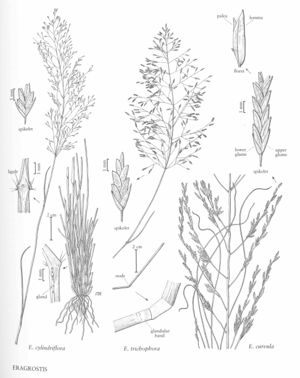Eragrostis trichophora
Plants perennial; cespitose, stoloniferous, forming innovations near the base. Culms 30-70 cm, erect, geniculate, or prostrate, often rooting at the lower nodes, glabrous, with a ring of glands below the nodes. Sheaths glabrous or with scattered papillose-based hairs over most of the surface, apices pilose, hairs 1-4 mm, a ring of oblong glands sometimes present below the collar; ligules 0.2-0.5 mm; blades 1.4-10 cm long, 2-3 mm wide, flat to involute, sparsely hairy with papillose-based hairs, abaxial surfaces often with glandular dots. Panicles 5-20 cm long, 2-7 cm wide, narrowly ovate, open; primary branches 2-7 cm, diverging 10-70° from the rachises, lowest branches whorled, naked proximally, bases with a glandular band; pulvini hairy; pedicels 0.3-3.3 mm, glandular. Spikelets 4-5.4 mm long, 1-1.5 mm wide, linear-lanceolate, plumbeous to greenish-gray, with 3-5 florets; disarticulation acropetal, paleas persistent. Glumes subequal, 1.4-1.8 mm, ovate-lanceolate, membranous; lemmas 1.5-1.8 mm, ovate, membranous, often hyaline, lateral veins inconspicuous, apices obtuse to acute; paleas 1.3-1.7 mm, hyaline, bases not projecting beyond the lemmas, apices obtuse; anthers 3, 0.7-1 mm, purplish. Caryopses 0.6-0.8 mm, ovoid, terete to dorsally compressed, shallowly grooved adaxially, translucent, mostly whitish to light brown, bases often greenish. 2n = unknown.
Distribution
Md.
Discussion
Eragrostis trichophora is native to Africa, where it often grows in moist, disturbed or overgrazed sites. It has been collected from disturbed sites at Canton, Maryland.
Selected References
None.
